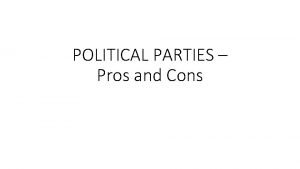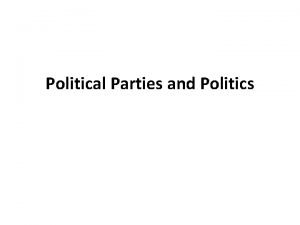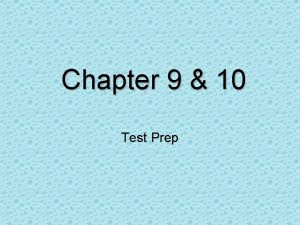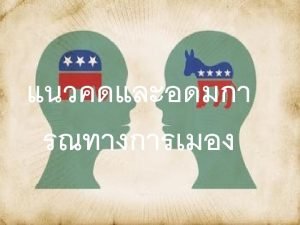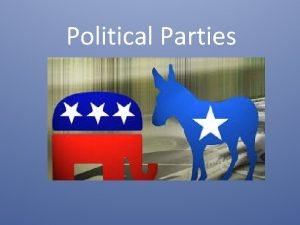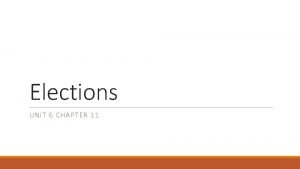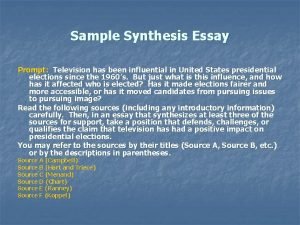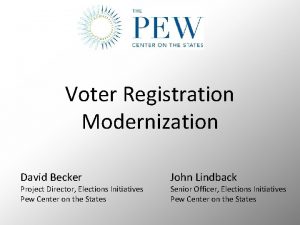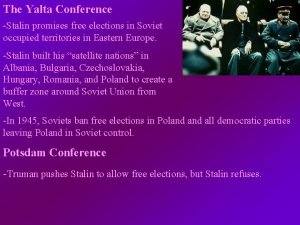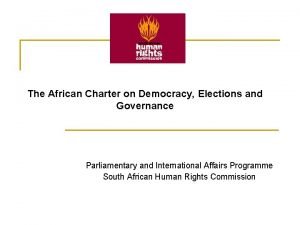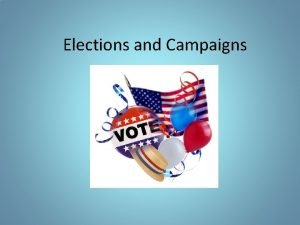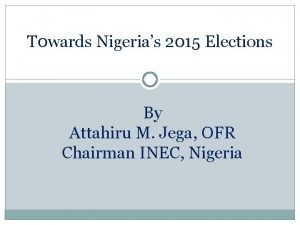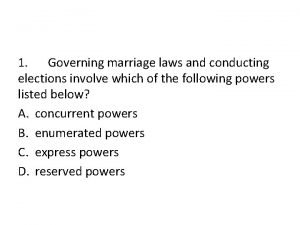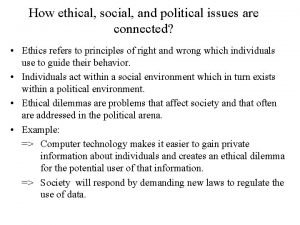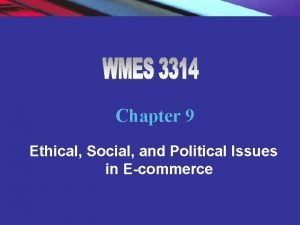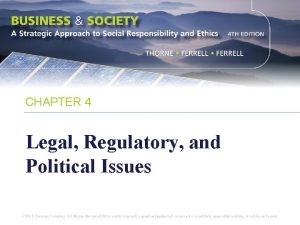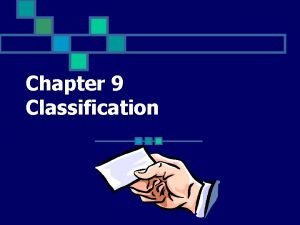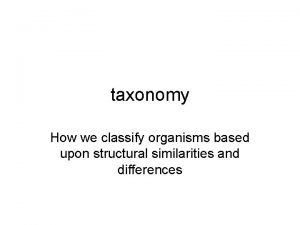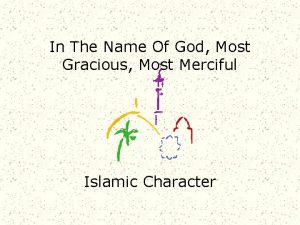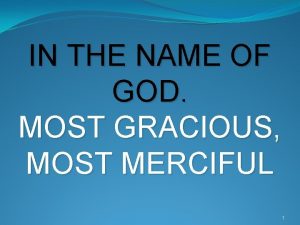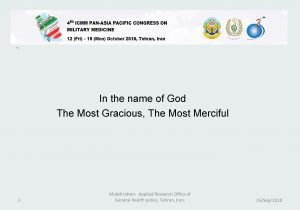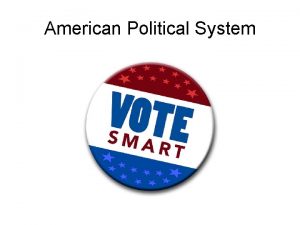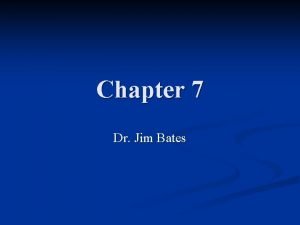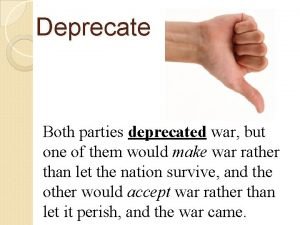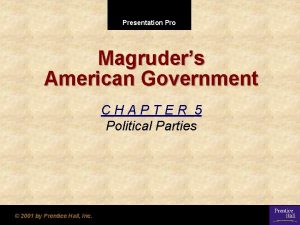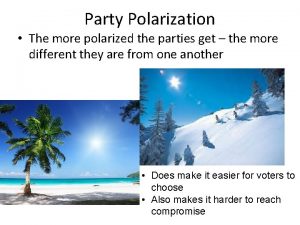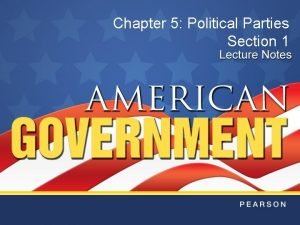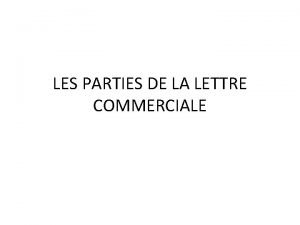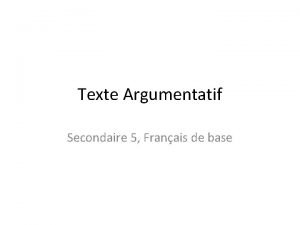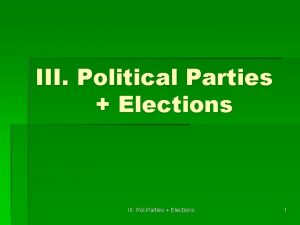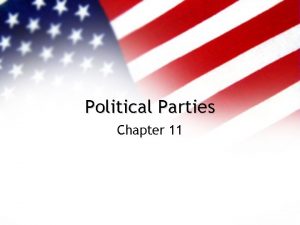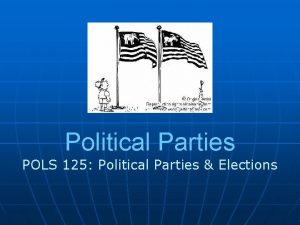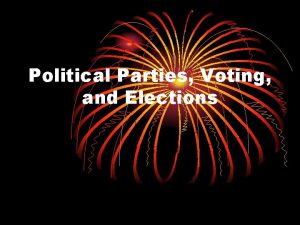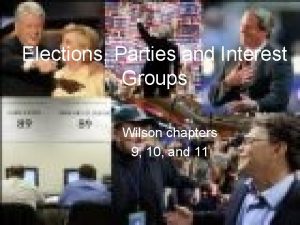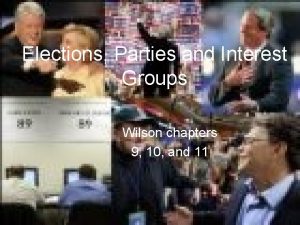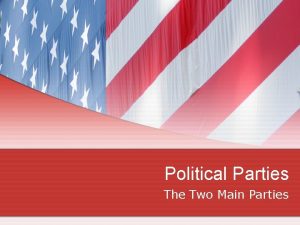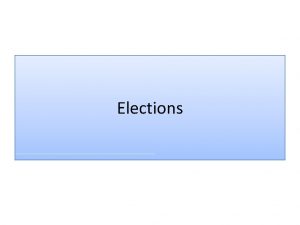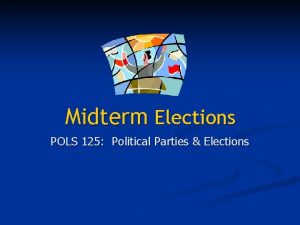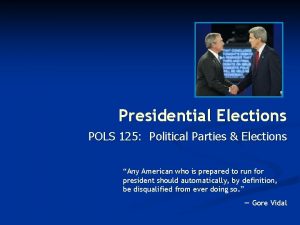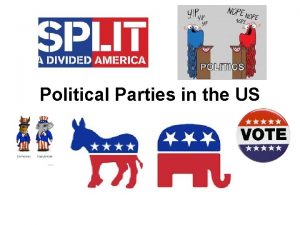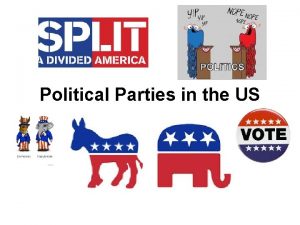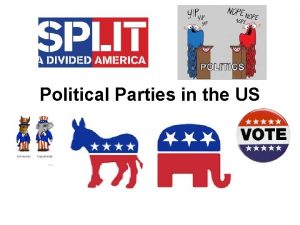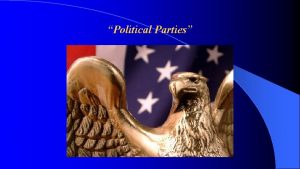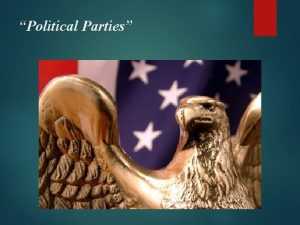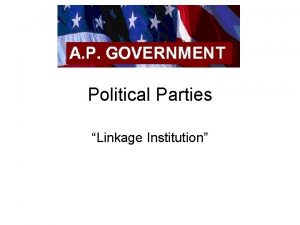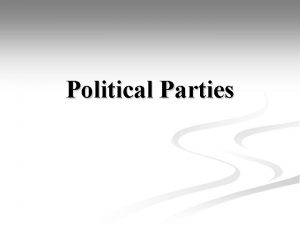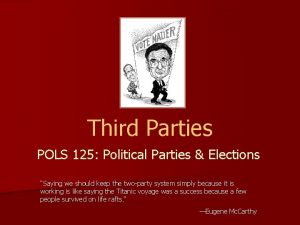POLITICAL PARTIES Issues or Elections Most political parties










































- Slides: 42

POLITICAL PARTIES

Issues or Elections? • Most political parties are made up of people who are committed to a common set of public policies and programs. • The Democratic and Republican parties in the U. S. are coalitions that are election-oriented rather than issueoriented.

• Political party: a group of people who seek to control government through the winning of elections & the holding of public office. • The 2 major political parties are Republican & Democratic. • Neither the Republican nor Democratic parties are comprised of like-minded people. They do not agree on the same issues, but share similar views on many public questions.

• Many feel that political parties are the principal means by which the will of the people is made known to government & by which government is held accountable. • Political parties bring conflicting groups together. – They modify & compromise the conflicting views of different interests & groups & help unify rather than divide the people.




• Watchdog: parties act to safeguard the conduct of the public’s business by such means as criticizing the policies & behavior of the party in power, which is usually the party that controls the executive branch. – It tries to convince the voters to throw out politicians they feel are not doing a good job. – The party that is not in power acts as the “loyal opposition. ”

THE TWO-PARTY SYSTEM • The Republican & Democratic parties dominate U. S. politics, which is why we have a two-party system. – In a typical election only the candidates of the Republican & Democratic parties have a reasonable chance of winning an election. • In some states one of these two major parties may be overwhelmingly dominant.

• • MAJOR FUNCTIONS OF POLITICAL PARTIES Nominating: the major function of a political party is to nominate candidates for public office. Informer-Stimulator: political parties help inform people & stimulate their interest & participation in public affairs. Bonding: parties ensure the capable performance of its candidates by making sure the candidates are qualified. Governmental: parties provide a basis for the conduct of government. – Congress & state legislatures are organized & conduct business on a partisan basis.

• Historical Basis: Although the founding fathers were opposed to political parties, with the ratification of the Constitution came the birth of our first two parties: the Federalists, led by Alexander Hamilton, and the Anti-Federalists, led by Thomas Jefferson. • Force of Tradition: The very fact that we began with a two-party system has been a leading reason for its retention.

• The electoral system promotes the existence of but a two-party system. – Single-member district: nearly all elections held in the U. S. are single-member district elections. They are contests in which only one candidate is to be elected to each office on the ballot. The winning candidate is the one who receives a plurality (largest #) of votes cast. • Works to discourage third parties because only one winner can come out of each contest & voters think of a vote for a third-party candidate as a “wasted” one. • There is a deliberate intention to discriminate against minor parties by practices such as not listing the minor candidate on the ballot. • Eugene V. Debs of the Socialist Party was the first minor party candidate to make it on the ballot everywhere, in 1912.

• Ideological Consensus: there is a broad consensus among Americans in fundamental matters. – Bitter disputes based on economic class, social status, religious beliefs, or national origins have not been typical of politics. Those conditions that could produce strong rival parties simply do not exist in the U. S. – Both parties tend to be moderate, built on compromise and try to stay in “the middle of the road. ” – Both parties seek the support of the majority of the voters, & therefore each party takes a policy stand very much like the other party. – Often the competition becomes a struggle between competing political personalities.

• Another reason the two-party system persists is that U. S. election law is written to discourage third parties & additionally, is intentionally framed to preserve & defend the two-party system. • Ideologically homogeneous: Americans as a whole share the same ideals, basic principles and patterns of beliefs. In general, there is a broad consensus in fundamental matters.



Proponents of a Multiparty System • Some would replace the two-party system with a multiparty system in which several major & lesser parties exist. – Most European democracies have multiparty systems. • The various parties would be based on some distinctive interest, such as economic class, religious belief, or political ideology. – Proponents of the multiparty system feel it would be more responsive and representative of the will of the people. – They feel it would give voters more choice among candidates & policy alternatives.





ONE-PARTY SYSTEMS • Most dictatorships have only one political party – the party of the ruling clique. • The one-party system is really a “no-party system” • In the U. S. , some states can be described as oneparty because one of the major parties dominates the state. For example, until the late 1950 s, the Democrats almost completely dominated the politics of the South. While in the New England upper Mid-west, the Republican party has dominated.


PARTY AFFILIATION • Membership in either major party is voluntary, or the person may belong to a minor party or is an independent. • The Republican and Democratic parties are broadly based. They are multi-class and try to attract as much support from as many groups & individuals as possible. – Each party is usually composed of diverse sections of the population.



GENERAL TRENDS • Members of certain segments of voters tend to align themselves more solidly with one or the other of the major parties. – In recent years, non-caucasians, Catholics, Jews & labor union members have voted more often for Democrats. – Caucasian males, Protestants & those from the business community have voted more often for Republicans (GOP). – Nearly 2 out of every 3 voters follow the party allegiance of their parents. – Higher income groups are more likely to think of themselves as Republicans – Those with lower incomes tend to think of themselves as Democrats. – Other factors that influence party affiliation are: age, place of residence, level of education & work environment.

HISTORICAL FOUNDATIONS • The Federalist Party was the first political party. – It was formed around Alexander Hamilton, the Secretary of the Treasury. – Federalists believed in a strong central government. – Most were from the well-to-do and the rich. – They favored strong executive leadership in correcting the ills of the U. S. economy. – They favored a “liberal” interpretation of the Constitution.

• The second political party to be formed were the Anti-Federalists led by Thomas Jefferson. – – – They were sympathetic to the “common man. ” They favored limited government control. They adhered to a strict construction of the Constitution. – Later the Anti-Federalists became known as the Jeffersonian Republicans, or the Democratic. Republicans. Although by 1828 they became known simply as the Democratic Party.





AGAIN. . . PARTY ORGANIZATION • The basic goal of the major parties is to gain control of government by winning elective office. • The prime function of the major parties is the making of nominations.

• There are four major elements in the structure of both major parties: the national convention, the national committee, the national chairperson, and the congressional campaign committees. • National Convention: it meets every presidential election year in the summer. – It nominates the presidential and vicepresidential candidates.

• The National Committee: when there are no National Conventions meeting, the National Committee handles the political party’s business. • The National Chairperson: heads up the National Committee. S/he is chosen to a four-year term by the National Committee. – The chair directs the work of the party’s headquarters & its small staff. – S/he works to strengthen the party & its treasury, promoting party unity, raising money, recruiting new voters & preparing for the next presidential election.

• Congressional Campaign Committees: each party has a campaign committee in each house of Congress – a Congressional Campaign Committee in the House & a Senatorial Campaign Committee in the Senate. – Both works to re-elect incumbents & save seats given up by retiring party members. – In both houses, the members of these campaign committees are chosen by their colleagues and

Left v. Right • Left wing beliefs are usually progressive in nature, they look to the future, aim to support those who cannot support themselves, are idealist and believe in equality. People who are left wing believe in taxation to redistribute opportunity and wealth - things like a national health service, and job seeker’s allowance are fundamentally left wing ideas. They believe in equality over the freedom to fail. • Right wing beliefs value tradition, they are about equity, survival of the fittest, and they believe in economic freedom. They typically believe that business shouldn’t be regulated, and that we should all look after ourselves. Right wing


• • Tea Party Patriots Constitution Party The Green Party Libertarianism


 Political parties pros and cons
Political parties pros and cons Brainpop political parties
Brainpop political parties Political party
Political party What was one way progressives differed from populists
What was one way progressives differed from populists Soup and ideology
Soup and ideology Political parties
Political parties Political parties
Political parties The supreme court change
The supreme court change “elections are key to democracy”
“elections are key to democracy” Ap lang synthesis essay television presidential elections
Ap lang synthesis essay television presidential elections David becker elections
David becker elections Stalin promise free elections
Stalin promise free elections African charter on democracy, elections and governance
African charter on democracy, elections and governance Presidential elections exploration and announcement
Presidential elections exploration and announcement Conclusion on elections
Conclusion on elections Governing marriage laws and conducting elections
Governing marriage laws and conducting elections How ethical social and political issues are connected
How ethical social and political issues are connected Ethical social and political issues in e-commerce
Ethical social and political issues in e-commerce Legal regulatory and political issues
Legal regulatory and political issues The arrangement chapter 9
The arrangement chapter 9 Most general to most specific classification
Most general to most specific classification Most beneficent
Most beneficent Ponceau pronunciation
Ponceau pronunciation The most gracious
The most gracious In the name of god most gracious most merciful
In the name of god most gracious most merciful Most general to most specific classification
Most general to most specific classification In the name of allah the most beneficent the most merciful
In the name of allah the most beneficent the most merciful Aqidah
Aqidah In the name of allah the most gracious
In the name of allah the most gracious In the name of allah the most gracious the most merciful
In the name of allah the most gracious the most merciful Crayfish taxonomy
Crayfish taxonomy In the name of god most gracious prayer
In the name of god most gracious prayer In the name of allah, the beneficent, the merciful
In the name of allah, the beneficent, the merciful In the name of allah the most beneficent the most merciful
In the name of allah the most beneficent the most merciful Socialist parties
Socialist parties Why does tom insist daisy go home with gatsby
Why does tom insist daisy go home with gatsby Both parties deprecated war meaning
Both parties deprecated war meaning Chapter 5 section 1 parties and what they do
Chapter 5 section 1 parties and what they do What does the graph indicate?
What does the graph indicate? American literature jeopardy
American literature jeopardy Chapter 5 section 1 parties and what they do
Chapter 5 section 1 parties and what they do Parties de la lettre
Parties de la lettre Texte argumentatif structure
Texte argumentatif structure
